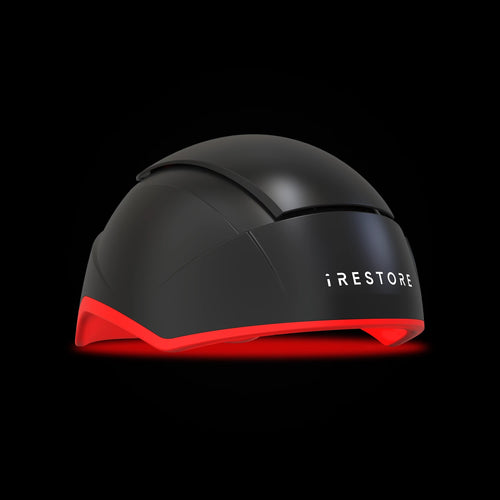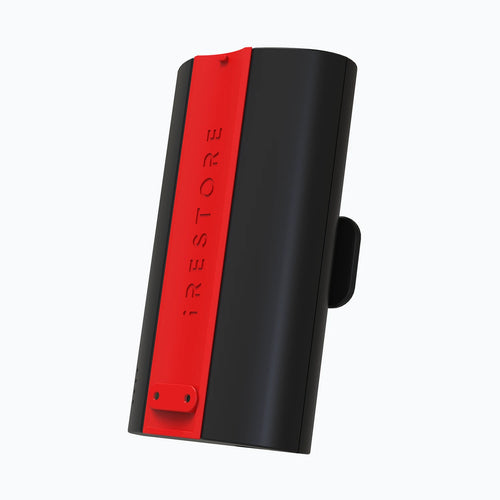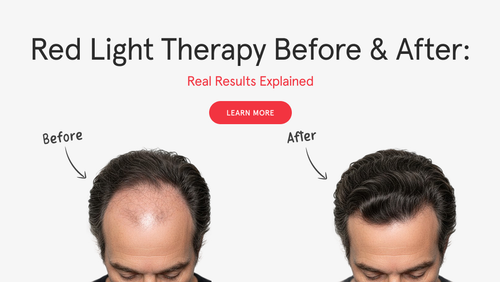Noticing strands grow thinner, softer, and shorter? That’s often hair miniaturization, the early, silent step toward pattern hair loss. As follicles shrink, each new hair emerges with a smaller diameter and a shorter growth phase, making the scalp look progressively more visible.
The upside is early action helps. Dermatologist-approved options like FDA-cleared red light therapy support follicle energy, scalp microcirculation, and healthier growth, before thinning becomes harder to address.
What Is Hair Miniaturization?
Hair miniaturization is the gradual shrinking of hair follicles that leads to thinner, weaker strands over time. It’s a key process behind pattern hair loss, where healthy terminal hairs slowly turn into fine, wispy vellus hairs that barely cover the scalp.
This happens when the hair growth cycle shortens. The anagen (growth) phase becomes briefer, and the resting (telogen) phase lengthens, so each new strand grows back finer and sheds more easily. Over time, the follicle becomes so small that it can no longer produce visible hair.
The process is often triggered by dihydrotestosterone (DHT), the same hormone linked to mature vs. receding hairlines in men and women, a hormone that binds to receptors in hair follicles and causes them to shrink. While DHT sensitivity is largely genetic, environmental factors like stress, poor scalp health, and nutritional deficiencies can accelerate the cycle.
Recognizing hair miniaturization early is crucial because follicles that haven’t completely closed can still respond to treatment and begin producing thicker, healthier hair again.
Causes of Hair Miniaturization
Several factors can trigger or accelerate hair miniaturization, gradually weakening the follicles and disrupting normal growth cycles.
1. Hormonal Factors (DHT Sensitivity):
The most common cause is a hormone called dihydrotestosterone (DHT), a byproduct of testosterone that binds to follicle receptors. Over time, DHT causes the follicle to shrink, leading to finer, shorter strands and eventually dormant follicles.
2. Genetic Predisposition:
If pattern hair loss runs in your family, chances are your follicles are genetically more sensitive to DHT. This hereditary form of miniaturization is known as androgenetic alopecia and can start as early as your 20s or 30s.
3. Scalp Health and Circulation:
Poor scalp health, excess buildup, or reduced blood flow can limit the nutrients reaching your follicles. Inflammation or clogged pores around the follicles can further restrict healthy growth.
4. Stress and Lifestyle Factors:
High stress, lack of sleep, and nutritional deficiencies (especially iron, zinc, and vitamin D) can all accelerate follicle weakening. Harsh treatments and tight hairstyles that strain the scalp can make it worse, much like wearing a hat too tightly over time.
Addressing these root causes early by improving scalp circulation, supporting hormonal balance, and protecting follicle health can help slow or even reverse miniaturization before permanent loss occurs.
Can Hair Miniaturization Be Reversed?
In many cases, yes, hair miniaturization can be slowed or partially reversed, but only if the follicles are still active. Once a follicle becomes completely dormant, regrowth becomes difficult. That’s why early detection and consistent treatment matter most.
Reversing miniaturization focuses on restoring follicle health and prolonging the hair growth cycle. Dermatologists often recommend:
-
Low-Level Laser Therapy (LLLT): Boosts cellular energy and blood flow to help revive miniaturized follicles, especially when used with the optimal red light wavelength (650nm vs. 850nm).
-
DHT Blockers: Medications or topical treatments that prevent DHT from binding to follicles.
-
Topical Minoxidil: Encourages follicles to stay longer in the growth (anagen) phase.
-
Nutritional Support: Balanced intake of protein, iron, zinc, and biotin to strengthen hair at the root.
When started early, these approaches can thicken hair shafts, improve scalp density, and reactivate weaker follicles helping you preserve your natural hair longer.
How Red Light Therapy Helps Counter Hair Miniaturization
Red light therapy, also known as Low-Level Laser Therapy (LLLT), is one of the safest and most effective ways to address hair miniaturization at its root cause and works best when used consistently, discover how often to use red light therapy for results. Using clinically tested wavelengths of light (650–680 nm), this therapy re-energizes dormant or weakened follicles by stimulating cellular activity and restoring scalp circulation.
When light energy penetrates the scalp, it boosts ATP production, the energy source for cells improving oxygen and nutrient delivery to the follicles. This helps reactivate the growth (anagen) phase, leading to thicker, fuller hair over time.
Clinical studies show that consistent red light therapy can significantly improve hair density, strand thickness, and overall scalp health, making it an ideal early intervention for miniaturization.
iRESTORE’s FDA-cleared red light therapy system uses this proven technology to help restore your hair naturally and safely at home.
Try the iRESTORE Laser Hair Growth System, trusted by thousands for visible results in just a few months.

When to Seek Professional Help for Miniaturization
If you’re noticing consistent thinning, widening parts, or a more visible scalp, it’s time to consult a professional. Early diagnosis matters, a dermatologist or trichologist can confirm whether hair miniaturization is the cause and recommend treatments based on your hair’s current growth stage.
A professional evaluation may include scalp imaging (trichoscopy), hormonal analysis, or nutrient testing to identify contributing factors such as DHT sensitivity, inflammation, or deficiencies.
Combining professional care with home-based solutions like FDA-cleared red light therapy often delivers the best results. Medical guidance ensures you address both internal and external causes of thinning while red light therapy helps re-energize weakened follicles and support long-term regrowth.
Conclusion
Hair miniaturization doesn’t happen overnight, it’s a gradual process that gives you time to act. Recognizing it early and choosing evidence-based treatments can make a real difference in keeping your hair stronger for longer.
With consistent care, healthy scalp habits, and technologies like iRESTORE’s FDA-cleared red light therapy, you can help slow miniaturization, reactivate weaker follicles, and restore confidence in your hair’s natural growth cycle.
Taking action at the first signs of thinning is the key to prevention and the first step toward healthier, fuller hair.
FAQs
How can I tell the difference between normal shedding and hair miniaturization?
Normal shedding involves full-sized strands with visible roots, while miniaturization causes hairs to regrow thinner, softer, and shorter. A dermatologist or trichologist can confirm through scalp imaging.
Does hair miniaturization affect men and women differently?
Yes. In men, miniaturization often starts at the temples or crown, leading to receding patterns. In women, it typically appears as overall thinning along the part or top of the head.
How long does it take to see improvement after starting red light therapy?
Most users notice reduced shedding and thicker regrowth within 3–6 months of consistent use. Results vary depending on the stage of miniaturization and overall scalp health.
Can stress cause or worsen hair miniaturization?
Yes. Chronic stress increases cortisol, which can disrupt the hair growth cycle and accelerate miniaturization. Managing stress through sleep, exercise, and relaxation can support recovery.
Disclaimer: The iRESTORE blog is for informational purposes only and is not intended to replace professional medical advice or treatment. Please do not ignore professional guidance because of information you’ve read here. If you have concerns about your hair or skin health, we encourage you to consult a qualified healthcare professional.



















